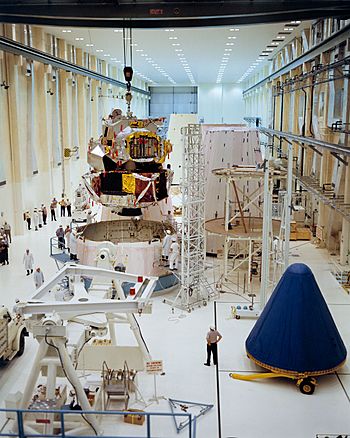Apollo 5 facts for kids

Lunar Module 1 being mated to the Spacecraft Lunar Module Adapter (SLA) in preparation for launch as Apollo 5
|
|
| Mission type | Lunar module test flight |
|---|---|
| Operator | NASA |
| Mission duration | 11 hours, 10 minutes |
| Orbits completed | 7 |
| Spacecraft properties | |
| Spacecraft | Apollo LM-1 |
| Manufacturer | Grumman |
| Launch mass | 14,360 kilograms (31,660 lb) |
| Start of mission | |
| Launch date | January 22, 1968, 22:48:09 UTC |
| Rocket | Saturn IB SA-204 |
| Launch site | Cape Kennedy LC-37B |
| End of mission | |
| Disposal | Uncontrolled reentry |
| Deactivated | January 23, 1968 9:58 UTC |
| Decay date | Ascent stage: January 24, 1968 Descent stage: February 12, 1968 |
| Orbital parameters | |
| Reference system | Geocentric |
| Regime | Low Earth orbit |
| Perigee | 162 kilometers (87 nmi) |
| Apogee | 214 kilometers (116 nmi) |
| Inclination | 31.6 degrees |
| Period | 89.5 minutes |
| Epoch | January 22, 1968 (ascent stage) |
|
|
|
Apollo 5 was the first unmanned test flight of the Apollo Lunar Module. The Apollo Lunar Module was the lander part of Apollo spacecraft. The module was launched on January 22, 1968 from Cape Canaveral Air Force Station.
Images for kids
-
Apollo 5's Saturn IB on the launchpad
-
Director of Flight Operations Christopher C. Kraft (left) and Manned Spaceflight Center director Robert R. Gilruth in Mission Control during Apollo 5
See also
 In Spanish: Apolo 5 para niños
In Spanish: Apolo 5 para niños

All content from Kiddle encyclopedia articles (including the article images and facts) can be freely used under Attribution-ShareAlike license, unless stated otherwise. Cite this article:
Apollo 5 Facts for Kids. Kiddle Encyclopedia.



